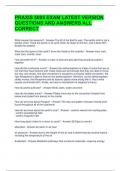Exam (elaborations)
PRAXIS 5005 EXAM LATEST VERSION QUESTIONS AND ANSWERS ALL CORRECT
- Course
- Institution
PRAXIS 5005 EXAM LATEST VERSION QUESTIONS AND ANSWERS ALL CORRECT What causes the seasons? - Answer-The tilt of the Earth's axis. The earths orbit is not a perfect circle. There are points in its cycle when its closer to the sun, and it does NOT dictate the weather What are the layers of the...
[Show more]



